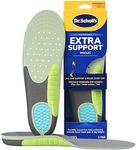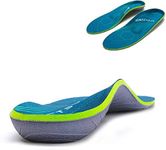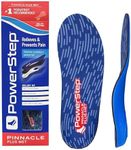Buying Guide for the Best Hiking Insoles
Choosing the right hiking insoles can significantly enhance your hiking experience by providing comfort, support, and protection to your feet. Insoles can help prevent foot fatigue, blisters, and other discomforts that can arise during long hikes. When selecting hiking insoles, consider the type of terrain you'll be hiking on, your foot shape, and any specific foot issues you may have. It's important to find insoles that fit well within your hiking boots and cater to your individual needs.Arch SupportArch support is crucial for maintaining proper foot alignment and reducing strain on your feet during hikes. Insoles come with varying levels of arch support, from low to high. Low arch support is suitable for those with flat feet or minimal arch, while medium support is ideal for average arches. High arch support is best for those with pronounced arches. Consider your foot's natural arch and any discomfort you experience to choose the right level of support.
CushioningCushioning in insoles helps absorb shock and reduce impact on your feet, especially when hiking on rocky or uneven terrain. Insoles can have light, medium, or heavy cushioning. Light cushioning is suitable for short hikes or those who prefer a more natural feel. Medium cushioning offers a balance between comfort and support, ideal for moderate hikes. Heavy cushioning provides maximum comfort and is best for long hikes or those with sensitive feet. Consider the length and difficulty of your hikes to determine the right level of cushioning.
MaterialThe material of the insoles affects their durability, comfort, and breathability. Common materials include foam, gel, and cork. Foam insoles are lightweight and provide good cushioning, making them suitable for general hiking. Gel insoles offer excellent shock absorption and are ideal for rugged terrains. Cork insoles are durable and provide natural support, perfect for eco-conscious hikers. Consider the type of hiking you do and your personal preferences to choose the right material.
FitEnsuring a proper fit is essential for comfort and effectiveness of the insoles. Insoles should fit snugly within your hiking boots without causing any pressure points or slipping. They come in various sizes and can be trimmed to fit your boots perfectly. Consider trying insoles with your hiking boots to ensure they fit well and provide the necessary support. If you have specific foot issues, custom insoles might be a better option.
Moisture ManagementMoisture management is important to keep your feet dry and prevent blisters during hikes. Insoles with moisture-wicking properties help draw sweat away from your feet, keeping them dry and comfortable. Look for insoles made with breathable materials or those with antimicrobial treatments to reduce odor and moisture buildup. Consider the climate and duration of your hikes to determine the importance of moisture management in your insoles.
















